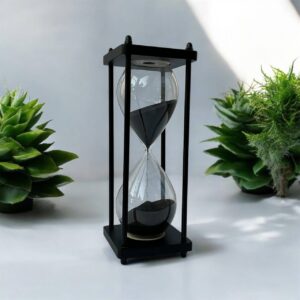
Introduction
Effective time management is essential for achieving success in various areas of life, including work, study, and personal pursuits.
Hourglasses, despite their simplicity, can be powerful tools for helping individuals better manage their time.
1. Understanding Hourglasses
Hourglasses, also known as sand timers, are ancient timekeeping devices consisting of two glass bulbs connected by a narrow passage.
When the hourglass is flipped, sand flows from one bulb to the other, indicating the passage of time.
Hourglasses come in various sizes and designs, but they all function on the same principle of gravity pulling the sand from one end to the other.

2. Why Sandclock Matter
Despite the prevalence of digital clocks and timers, hourglasses have endured throughout history due to their simplicity and reliability.
They have been used by civilizations around the world for tasks such as tracking cooking times, measuring intervals for religious rituals, and timing activities at sea.
Hourglasses offer a tangible and intuitive way to visualize the passage of time, making them valuable tools for time management in both ancient and modern times.
3. Using Hourglasses for Time Management
Hourglasses provide a physical representation of time passing, making it easier for individuals to stay focused on their tasks.
By watching the sand flow through the hourglass, people can gauge how much time they have left for a particular activity or work session.
The visual cue of the hourglass serves as a gentle reminder to stay on track and make the most of each moment, helping to combat procrastination and distractions.
4. Benefits of Hourglasses for Time Management
One of the primary benefits of using hourglasses for time management is their ability to promote focus and concentration.
The visual and auditory cues of the hourglass help individuals stay engaged in their tasks and maintain momentum until completion.
Additionally, hourglasses encourage mindfulness and present-moment awareness, as individuals are reminded of the fleeting nature of time with each grain of sand that falls.

5. Incorporating Hourglasses into Daily Routine
Hourglasses can be integrated into various time management techniques and strategies to enhance productivity and efficiency.
For example, the Pomodoro Technique involves working for a set period (usually 25 minutes) followed by a short break. An Sandclock can serve as a timer for each work session, signaling when it’s time to take a break.
Hourglasses can also be used to allocate specific time blocks to different tasks, helping individuals prioritize their activities and manage their workload effectively.
6. Real-Life Examples
Many students use Sandclock to improve their study habits and productivity. By setting a timer with an hourglass, students can focus on studying for a set period without getting distracted by external factors.
Professionals also utilize Sandclock to manage their time more effectively. For example, someone working on a project with multiple tasks can allocate specific time intervals for each task using an hourglass, ensuring that they stay on schedule and meet deadlines.
Conclusion
Hourglasses are simple yet powerful tools that can help individuals master time management in their daily lives.
By incorporating Sandclock into their routines, people can enhance their focus, concentration, and overall productivity.
Whether used for studying, working, or pursuing personal interests, Sandclock offer a timeless solution for better managing time and achieving success.









Add comment